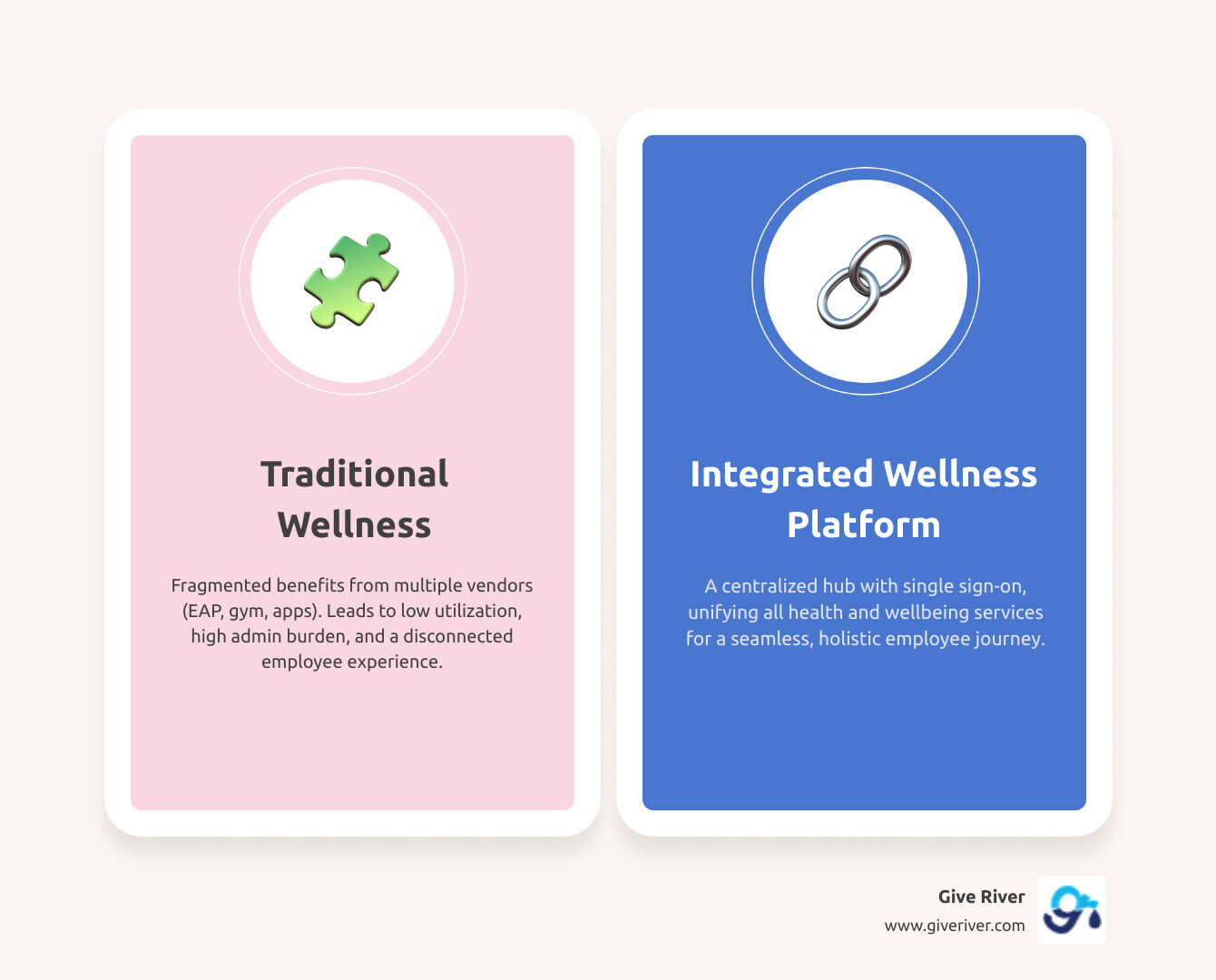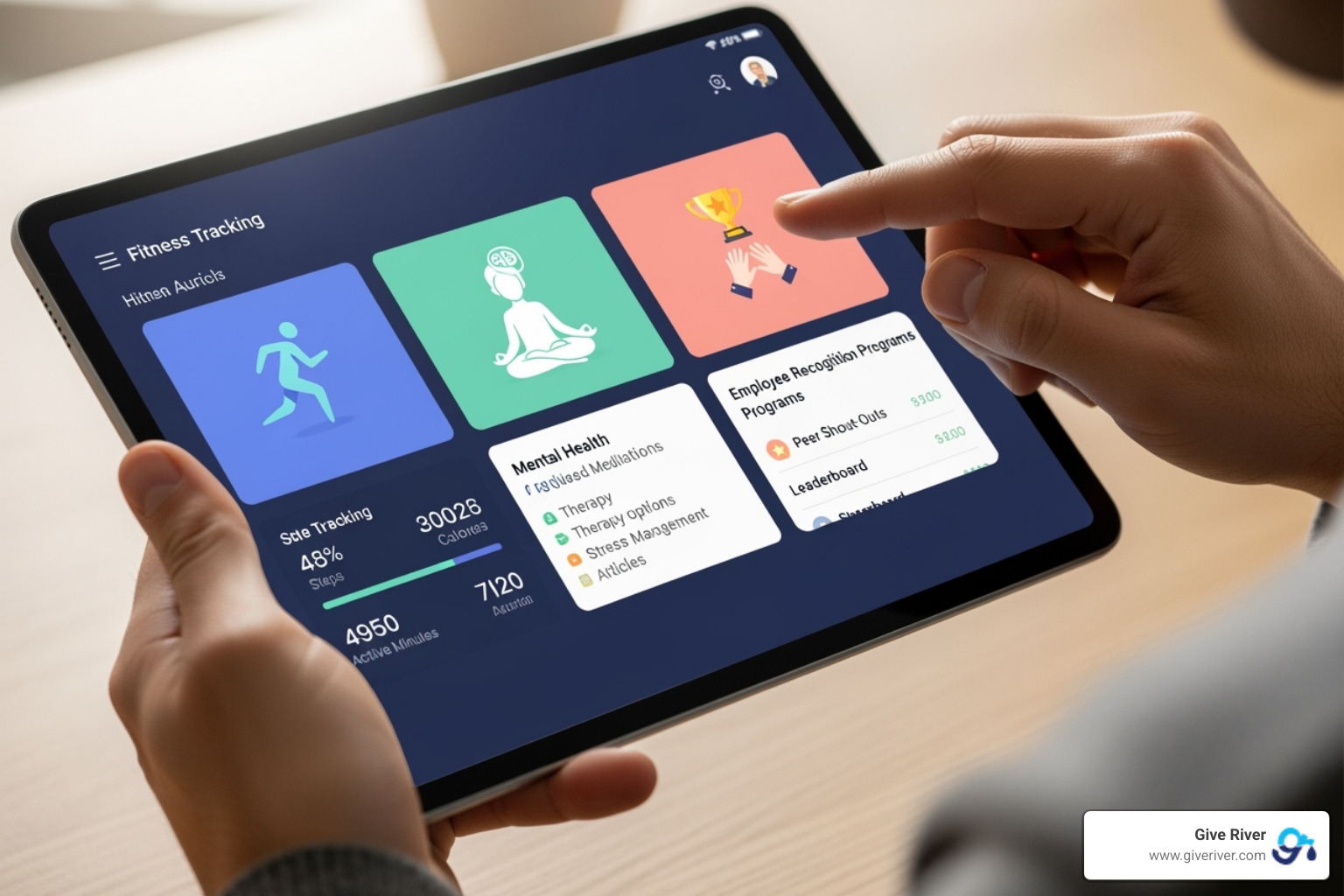Mind, Body, Spirit The Power of Integrated Wellness
Transform your workplace with an integrated wellness platform. Enhance employee well-being, productivity, and engagement.

What is an Integrated Wellness Platform and Why Does It Matter?
An integrated wellness platform is a comprehensive digital solution that unifies multiple health and wellbeing services—from mental health support and primary care to fitness programs and employee assistance—into a single, seamless experience for employees.
Quick Answer: Key Features of an Integrated Wellness Platform
- Single Sign-On Access: One login for all wellness programs and benefits
- Holistic Health Coverage: Mental health, physical wellness, financial guidance, and social support
- Data Integration: Connects wearables, health assessments, and personal metrics
- Personalized Experience: AI-driven recommendations based on individual needs
- Real-Time Analytics: Actionable insights for both employees and employers
- 24/7 Virtual Care: Access to healthcare professionals and wellness coaches
The numbers tell a compelling story. Research shows that 89% of employers using integrated platforms are less worried about productivity, while 42% report reduced concerns about talent retention. Even more striking: 30% of employees with access to integrated wellness report better work-life balance, compared to just 18% of those without.
But here's the reality many HR leaders face: traditional wellness programs are fragmented. Your team might have access to an Employee Assistance Program through one vendor, mental health apps through another, and gym memberships from a third provider. This siloed approach creates administrative headaches for you and confusion for employees who struggle to steer multiple platforms, passwords, and processes.
The shift toward integrated solutions isn't just about convenience—it's about creating a culture where employee wellbeing becomes as seamless as checking email. When 60% of absenteeism can be traced to mental health issues, a challenge highlighted by global health authorities like the World Health Organization, and only 39% of employees are satisfied with traditional EAPs, the case for integration becomes clear.
As Meghan Calhoun, Co-Founder of Give River, I've spent over two decades in high-pressure work environments learning how to create meaning, joy, and balance in the workplace—insights that directly inform our approach to developing comprehensive integrated wellness platform solutions. My experience has shown me that true employee fulfillment requires more than isolated wellness perks; it demands a holistic system that connects recognition, wellness, and growth into a unified experience.

Essential integrated wellness platform terms:
The Shift from Siloed Perks to Holistic Support
For too long, employee wellness has been a patchwork quilt of disconnected services. Organizations would offer a standalone gym membership, a separate Employee Assistance Program (EAP), perhaps a stress-management app, and then a different provider for virtual primary care. While each of these services might be valuable on its own, their isolation often leads to low utilization and a disconnected experience for employees. They're left to steer a maze of different logins, interfaces, and eligibility criteria, often feeling overwhelmed rather than supported.
This fragmentation is a relic of an older approach to benefits, where each health component was treated as a separate entity. However, we've come to understand that human health is not compartmentalized. Mental health impacts physical health, financial stress affects emotional well-being, and social connections are crucial for overall vitality. A siloed approach fails to acknowledge this interconnectedness, making it difficult for employees to find comprehensive support when they need it most.
For instance, an employee struggling with anxiety might benefit from mental health support, but their anxiety might also stem from financial worries or impact their sleep and physical activity. A traditional EAP might offer counseling, but it might not seamlessly connect them to financial advisors or provide tools to track their sleep and fitness. This is where the limitations of standalone programs become glaringly obvious. Employees often won't engage with programs if they're too difficult to access or don't feel relevant to their immediate, interconnected needs.
Defining the Integrated Approach
An integrated wellness platform, in contrast, acts as a centralized hub, a single digital front door for all aspects of an employee's well-being. Imagine your employees having one login, one dashboard, and one unified experience where they can access resources for their mind, body, and spirit. This is the essence of integration.
Our goal with an integrated wellness platform is to break down the walls between these various services. Instead of multiple vendors and scattered resources, everything is brought together under one roof. This means:
- Single Sign-On (SSO): Employees log in once and gain access to all available programs, from mental health resources to fitness challenges and financial planning tools. This simplicity drastically reduces friction and increases engagement.
- Unified Data and Personalization: By bringing data from various wellness touchpoints (e.g., health risk assessments, wearable devices, program participation) into a single system, the platform can offer truly personalized recommendations. If an employee is engaging with a stress reduction program, the platform might suggest complementary fitness activities or financial wellness webinars based on their overall profile.
- Proactive Care: An integrated system can identify trends and potential risks earlier, allowing for proactive interventions. For example, if an employee's engagement with mental health resources decreases while their absenteeism increases, the platform could prompt HR or a care manager to check in.
- Seamless Referrals and Continuity: If an employee starts with a virtual primary care visit for a stress-related symptom, the platform can seamlessly refer them to a mental health professional or a mindfulness program, ensuring continuity of care. Dialogue's platform exemplifies this, offering continuity of care by allowing members to consult with the same care team for follow-ups, and 70%+ of issues seen in traditional offices and clinics can be resolved virtually by their primary care professionals.
- Comprehensive Reporting for Organizations: For HR and leadership, this means a single source of truth for understanding employee well-being trends, program utilization, and overall impact. This data-driven insight is crucial for refining wellness strategies and demonstrating ROI.
The power of an integrated wellness platform lies in its ability to foster a holistic approach to health. It acknowledges that an employee's well-being is a complex interplay of various factors and provides a coordinated, user-friendly ecosystem to support every dimension of their health journey. This comprehensive approach is not just a convenience; it's a fundamental shift towards truly caring for your most valuable asset: your people.
The Anatomy of a Modern Integrated Wellness Platform

Think of a truly effective integrated wellness platform like the human body—every system working together in harmony to create optimal health. Just as your cardiovascular system supports your muscles, which in turn support your bones, a well-designed wellness platform connects all aspects of employee wellbeing into one seamless experience.
The beauty lies in the interconnections. When an employee uses the mental health resources, the platform can suggest complementary physical activities. When they engage with financial wellness tools, it might recommend stress-reduction techniques. This holistic approach mirrors how we actually experience wellbeing in our daily lives—not as separate compartments, but as interconnected pieces of a larger puzzle.
Core Components: Unifying the Pillars of Wellbeing
The most comprehensive platforms recognize that human wellness extends far beyond just physical health. From established frameworks like Ontario Shores' nine components of wellness, a robust integrated wellness platform should address the full spectrum of human needs.
Mental wellness forms the foundation, offering more than just crisis intervention. The best platforms provide cognitive behavioral therapy modules, mindfulness exercises, and stress management tools alongside access to licensed therapists. This is particularly crucial when we consider that 60% of absenteeism can be traced to mental health issues—yet traditional EAPs satisfy only 39% of employees.
Physical wellness goes beyond basic fitness tracking. Modern platforms integrate wearable devices, offer personalized workout plans, provide nutrition guidance, and even include sleep optimization tools. Companies like Welltory have shown remarkable success here, with their AI-driven approach helping 10M+ people better understand their body's signals for improved sleep, energy, and focus.
Financial wellness addresses one of the most significant sources of workplace stress. From budgeting tools to debt management resources, these components help employees achieve financial stability, which directly impacts their mental and physical health. Social wellness features foster healthy relationships through team challenges, community forums, and social events that build genuine connections among colleagues.
The platform also supports cognitive wellness through brain training exercises and focus improvement tools, while spiritual wellness components help employees find meaning and purpose through meditation guides and personal reflection resources. Occupational wellness ties directly into job satisfaction and work-life balance, while environmental wellness promotes healthy workspace practices.
For deeper insights into structuring these components effectively, explore our guides on Workplace Wellness Program Ideas and Corporate Wellness Fitness Programs.
Key Features That Drive Engagement and Results
The difference between a collection of wellness tools and a truly integrated platform lies in the intelligent features that make everything work together seamlessly. Personalization stands at the heart of this integration—generic advice simply doesn't work in today's diverse workplace environment.
Leading platforms like Sanko demonstrate the power of personalized approaches, with 9/10 users noticing health improvements within a week and 89% reporting noticeable health improvements since starting their personalized journey. This success stems from using AI-driven recommendations that analyze individual needs, lifestyle patterns, and goals to create truly relevant experiences.
The magic happens when data analytics connect the dots between different wellness activities. Welltory's AI enriches daily health guidance using data from over 1,200 supported apps and gadgets, helping users understand their body's signals for longevity. WellMe.ai takes this further by using behavior science and AI to understand users holistically, guiding them to the most suitable interventions.
Gamification transforms wellness from a chore into an engaging experience. Through challenges, points systems, leaderboards, and rewards, employees find themselves naturally drawn to participate. This taps into our fundamental desire for achievement and friendly competition—something Give River's unique 5G Method leverages to drive sustained engagement and motivate positive behaviors.
Wearable device integration creates a seamless flow of real-time health data, allowing platforms to provide immediate feedback and suggestions. Meanwhile, comprehensive Health Risk Assessments (HRAs) serve as the foundation for personalized recommendations. Companies like Integrated Health 21 have achieved industry-leading completion rates by focusing on user-friendly design and licensed algorithms.
These features work together to create an active partnership in each employee's health journey. For a deeper dive into the technology that makes this possible, check out our resources on Corporate Wellness Tools: The Ultimate Guide and Employee Wellness Software.
The Dual Benefit: A Win-Win for Employers and Employees
The most compelling aspect of an integrated wellness platform is how it creates genuine value for both sides of the employment equation. This isn't about choosing between employee satisfaction and business results—it's about achieving both simultaneously.
For employers, the benefits translate directly to the bottom line. Reduced absenteeism means fewer disruptions to productivity and lower costs associated with temporary staffing or overtime. When employees have easy access to mental health support, physical wellness resources, and financial guidance, they're more likely to address health issues proactively rather than waiting for them to become serious problems requiring extended time off.
Increased productivity emerges naturally when employees feel supported in all aspects of their wellbeing. Research shows that 89% of employers using integrated platforms are less worried about productivity, while 42% report reduced concerns about talent retention. This peace of mind allows leadership to focus on growth and innovation rather than constantly managing turnover crises.
For employees, the benefits center on genuine quality of life improvements. Better work-life balance becomes achievable when wellness resources are easily accessible and integrated into their daily routine. 30% of employees with access to integrated wellness report better work-life balance, compared to just 18% of those without—a significant difference that impacts everything from family relationships to personal fulfillment.
The platform also delivers improved health outcomes through coordinated care and proactive interventions. When mental health, physical wellness, and financial stability are addressed together, employees experience more comprehensive improvements than they would from isolated programs.
Perhaps most importantly, employees gain easier access to care through the single sign-on experience. Instead of navigating multiple vendors, passwords, and eligibility requirements, they can access everything they need through one familiar interface. This removes the friction that often prevents people from seeking help when they need it most.
This comprehensive approach is a key differentiator from platforms that specialize in a single area. For instance, platforms like Bonusly or Kudos are excellent at fostering a culture of recognition through peer-to-peer rewards and praise. However, they primarily focus on the social and occupational pillars of wellness. A truly integrated wellness platform must go further by seamlessly incorporating holistic health features. This is where Give River stands apart: by uniting recognition, wellness, and community impact in one experience, we ensure that celebrating an achievement can be as much a part of an employee's wellbeing journey as accessing a mindfulness session. Our Employee Wellness Platform Solutions approach ensures that every interaction supports both individual wellbeing and organizational success.
This dual benefit creates a positive cycle: healthier, more engaged employees contribute to better business outcomes, which in turn allows companies to invest more in employee wellbeing. It's a sustainable model that builds stronger organizations and happier people. For more insights on these interconnected benefits, explore our articles on Employee Wellness and Productivity and Employee Engagement and Retention.




